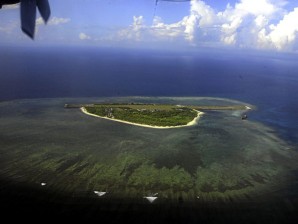Philippines pulls Spratlys ‘foreign’ posts

Aerial photo of the Philippine occupied Kalayaan island in the contested Spratlys group of islands. INQUIRER/Ernie U. Sarmiento
The Philippine Navy removed “foreign” markers installed on three reefs and banks in disputed isles off Palawan in May and foiled an attempt last week to reestablish them, officials said on Wednesday.
Lt. Col. Omar Tonsay on Wednesday told Agence France-Presse that the removal of the wooden posts last month took place just before Manila protested the alleged incursions by the Chinese Navy into Philippine waters.
“These were foreign markers because they were not installed by our military or our government. So we dismantled the markers because they are part of Philippine territory,” the Philippine Navy spokesperson told the French news agency.
Manila has accused Beijing of putting posts and a buoy in Philippine waters, but Tonsay said the Navy had not been able to determine who placed the wooden posts.
“They did not have a ‘Made in China’ label or anything,” Tonsay said, adding the posts had only numbers on them.
The markers were on Iroquois (Amy Douglas) Bank, Recto (Reed) Bank and Boxall Reef, all in the West Philippine Sea (South China Sea), he said.
“On June 5 again it was reported that our local fishermen found another marker,” said Commodore Edgardo Tamayo, commander of the Naval Forces West based in Palawan.
“I directed our patrol boat to check on the veracity of the report, and that was in Boxall Reef, only about 20 nautical miles [37 kilometers] away from Ayungin Shoal,” Tamayo said in a phone interview.
He said his forces had dismantled the marker on the reef, a Philippine Navy-occupied islet within the chain of islands that the Philippines collectively calls the Kalayaan Island Group. It is located 194 km (105 nautical miles) from mainland Palawan.
Defensive position
In Puerto Princesa City, Lt. Gen. Juancho Sabban told the Palawan provincial board that the Armed Forces of the Philippines would take a defensive position if challenged by China.
“We will fire only when fired upon. That is our rule of engagement,” the Western Command chief said on Tuesday, reacting to questions from board members about China’s reported plan to explore for oil in the region.
“In terms of military capability, we are very limited that is why we employ diplomatic means to resolve issues with China,” Sabban later told reporters.
The discovery of the marker in Boxall Reef came in the heels of the discovery on May 24 of steel posts, a buoy and other building materials laid out by Chinese vessels in Iroquois Reef, which the Philippines claims to be within its 370-km (200-nautical-mile) exclusive economic zone.
Manila filed a diplomatic protest over the Iroquois Reef incident, saying China “aggressively violated” the 2002 Declaration of Conduct of Parties in the South China Sea.
The 2002 nonbinding agreement signed by member states of the Association of South East Asian Nations (Asean) and China urges the claimant states to exercise restraint and avoid activities that might escalate tension, such as construction of military facilities and holding war games.
The Spratlys is claimed in whole or in part by six nations—the Philippines, China, Vietnam, Taiwan, Malaysia and Brunei.
No markings
Tamayo said Filipino fishermen saw activity in Boxall Reef during the first few days of June and then reported to the Navy on June 5 that they had spotted a marker.
“Our floating assets saw and confirmed the marker, the same marker that was found at Amy Douglas. That marker has the same description,” he said.
He said the marker was about 10 feet long and about four inches wide and likened it to a flat bar.
“This was confirmed to be found at the Boxall Reef,” he said, adding the marker was dismantled on June 6.
“We pulled out the marker to serve as evidence to prove that we saw that in that place,” Tamayo added.
“We did not see any markings that will tell us (it came from the) Chinese, (nor) any Chinese characters. So I surmise it is suspected from foreign origin. According to our informants, they suspect it to be Chinese because at that time they witnessed while it is being laid out,” he said.
Code of conduct
Tamayo said the Philippine Navy subscribed to the intention of the Declaration of Conduct to avoid any conflict.
“Personally I should say that following the intention of the conduct, supposedly we should be on status quo, meaning to say that we avoid putting up any particular structures like markers that would raise tension or raise conflict. That was the intention of the code of conduct.
A spokesperson at the Department of Foreign Affairs declined to comment on the naval action, but Malacañang was heaving a sigh of relief following a statement by Chinese foreign ministry spokesperson Hong Lei that Beijing did not intend to use force in the Spratlys controversy.
“It is something that we will certainly welcome so at least we have in the region an assurance that no use of force will be necessary to resolve the situation here,” presidential spokesperson Edwin Lacierda told reporters. With reports from AFP; Norman Bordadora in Manila; and Redempto D. Anda and Maricar Cinco, Inquirer Southern Luzon